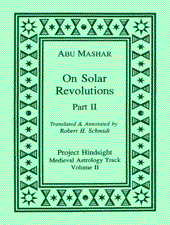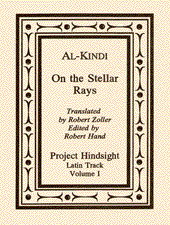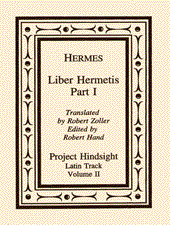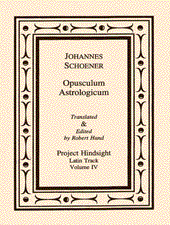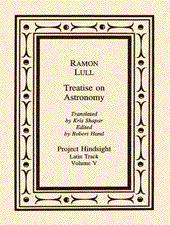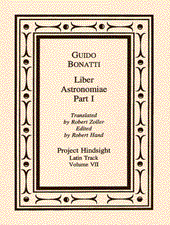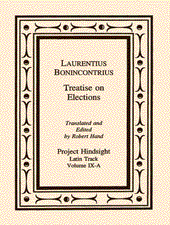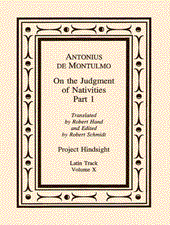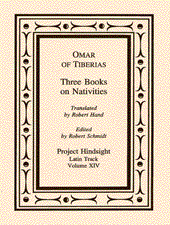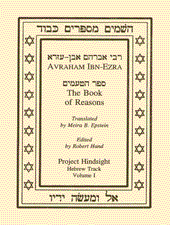Preliminary Translations
Medieval Track Translations
ABU MASHAR. ON SOLAR REVOLUTIONS, Part II.
ON SOLAR REVOLUTIONS is an extremely detailed and advanced Medieval treatise on the subject of solar returns. This work is so full of detail that Bob's standing joke is that if you really performed all the analysis suggested by Abu Mashar for a solar return, it would probably take about a year. Apart from it's great intrinsic interest, this work is important for two additional reasons. First, precious little remains of Hellenistic solar return doctrine although it was clearly considered to be important. This Arabian treatise may preserve Hellenistic material no longer available to us in earlier sources. Second, in any case, it is representative of important Arabian material that did NOT make it into the Medieval Latin tradition until the 16th century (it is not found in Bonatti or Leopold of Austria, for instance); therefore, this doctrine scarcely had time to be assimilated to the tradition before astrology nearly dropped out of the picture in the late 17th century.
ABU MASHAR. ON SOLAR REVOLUTIONS, Part I. (In preparation).
Phase I Latin Track Translations
Limited quantities of the following titles from the original Latin and Hebrew tracks are available, except as noted, while supplies last.
VOL. I: ALKINDI, ON THE STELLAR RAYS. Highly important early Arabic writing on astrological magic, attempting a rational explanation of astrological effects in terms of "rays," by one of the most important Islamic philosophers. Also invokes terrestrial "rays" as an explanation for the efficacy of amulets, incantations, curses, and sacrifice. A major influence in the development of both science and occultism in the West. Non-extant in Arabic. Out of print.
VOL. II: HERMES TRISMEGISTUS, LIBER HERMETIS, First Half. Latin astrological compendium that may contain translations of Hermetic material dating from 2nd century B.C.E., although much of the material is related to the Greek astrologers Vettius Valens and Rhetorius, and the Latin writer Firmicus Maternus. Describes powerful ancient imagery for the decanates. Contains two star catalogues. Lays out a "systematic" manner of chart reading that concentrates on the Sun and Moon. Treats most areas of life in the standard classical manner, and preserves a lot of detailed lore. Out of print.
VOL. III: HERMES TRISMEGISTUS, LIBER HERMETIS, Second Half. Delineations concerning the rising of fixed stars, planets in the ascendant, planets in the terms (bounds), planets in the domiciles of other planets, separations and applications, and assorted lunar doctrine. Out of print.
VOL. IV: JOHANN SCHOENER, OPUSCULUM ASTROLOGICUM. A convenient and well organized one-volume synopsis of late Medieval astrology prior to the work of the Renaissance revisionists, in which much of the material is tabulated for easy reference. Contains an introduction to astronomical matters, a complete survey of astrological principles, a lucid treatment of electional astrology, and a representative treatment of nativities. Out of print.
VOL. V: RAYMOND LULL, TREATISE ON ASTRONOMY, First Half. Sets forth the art of astrology as an abstract logic wherein delineation is at least partly reduced to a calculus of manipulating and combining letters. A good example of Lull's universal and systematic approach to all of knowledge. Strong emphasis on the Aristotelean elements, offering surprisingly elegant derivations of planetary combinations, and planet/sign combinations. Explanation of astrological workings in terms of Aristotelean formal causality. This translation has already generated considerable excitement in the astrological community because it to some extent anticipates some of Gauquelin's findings; it has renewed contemporary investigation into the nature and order of the elemental triplicities. This volume contains Book I of Lull's Treatise.
VOL. VI: RAYMOND LULL, TREATISE ON ASTRONOMY, Second Half. The remaining portion of Lull's Treatise, Books II - V. Includes the application of his Combinatory Art to every possible combination of planets in Aries, Taurus, Gemini, and Cancer; a section on objections to the ancient astronomy, and a final section section in a question and answer format.
VOL. VII: GUIDO BONATTI, LIBER ASTRONOMIAE, Unit One. Encyclopedic in scope (900 pages of dense Latin) and arguably the single most influential medieval astrological writing in the Latin West, this 13th century compendium gathered together all the strands of the Arabic tradition known in Bonatti's day. It is lucid, well-organized, and highly sophisticated philosophically. Unit One contains the First Tractate, which presents an argument for the importance of astrology and a theory of astral influence, and the first part of the Second Tractate, where Bonatti begins his instruction in the elements of astrology.
VOL. VIII: GUIDO BONATTI, LIBER ASTRONOMIAE, Unit Two. Contains the rest of the Second Tractate, completing Bonatti's introduction to the signs and houses.
VOL. IXa: LAURENTIUS BONINCONTRIUS, TREATISE ON ELECTIONS. Concise yet fairly thorough treatment of elections in the aphoristic style of the 15th century. A good browsing book. Out of print.
VOL IXb: MASHA'ALLAH, BOOK OF NATIVITES. A brief introduction into natal astrology containing 12 example charts written by one of the first astrologers to write in Arabic (even though Masha'Allah was himself Jewish), and a predecessor of Abu Ma'shar. Representative of Arab-style astrology. Extant only in Latin translation. Out of print.
VOL. X: ANTONIO DE MONTULMO, ON THE JUDGMENT OF NATIVITIES, First Half. Critical assessment of Medieval methods of rectification and life expectancy calculation, and other technical matters pertaining to nativities. Argumentative and rationalistic in style, this work influenced Regiomontanus and Schoener. Montulmo also wrote on magic.
VOL XI: BONATTI, LIBER ASTRONOMIAE, Unit Three. Contains all of the Third Tractate, dealing with the planets, completing Bonatti's introduction to the elements of astrology.
VOL. XII: ANTONIO DE MONTULMO, ON THE JUDGMENT OF NATIVITIES, Unit Two. The second half of Montulmo's work. Concludes his treatment of the Alcocoden. Includes chapters on Primary Directions, Abscissors, physical appearance, and planets as significators of the state of the soul, plus three appendices on Montulmo's Alcocoden function, primary directions, and the medieval method of evaluating the state of the soul.
VOL. XIII: BONATTI, LIBER ASTRONOMIAE, Unit Four, ON HORARY, First Part. Contains the first seven parts (about one fourth) of the Sixth Tractate, Bonatti's treatment of Horary astrology.
VOL. XIV: OMAR OF TIBERIAS, THREE BOOKS ON NATIVITIES. The life of Omar. Summary of the elements of later Arabic astrology and Latin astrology that are of probable Persian origin. The basis of this translation and the difficulties involved. Technical highlights and a discussion of the books in this Volume. Includes treatments of length of life, directive methods, profections, determining eminence, finding an unknown ascendant, and the investigation of topics using houses with related lots.
Phase I Hebrew Track Translation
HEBREW TRACK VOL. I: ABRAHAM IBN EZRA, THE BOOK OF REASONS. A further discussion of The Beginning of Wisdom, dealing with aspect & house theory, planetary spheres, signs & house classifications, dignities & debilities, precession, special degrees, and more. Written in a Talmudic conversational and didactic style, and clearly intended for someone already familiar with the basics. Out of print.
